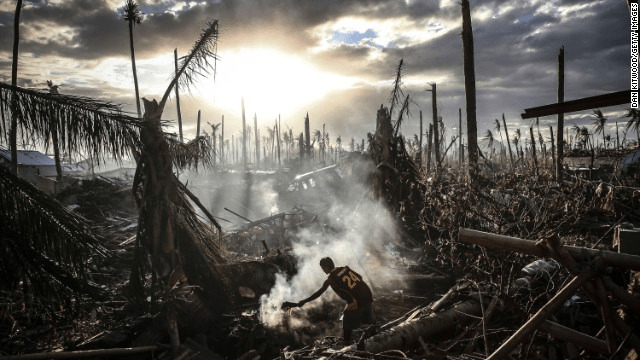Think of all the “natural disasters” with which we’re afflicted: tsunamis, earthquakes, volcanoes, storm surges, hurricanes, cyclones, and so on. And note that the impacts of such events are almost always worse if the human population affected is large. Typhoon Haiyan’s severity in 2013 was likely population related because the huge population of Homo sapiens is heating the planet and increasing the odds that typhoons will be more severe. But what is more obvious is that the extremely high density of the Philippine population (same as Japan) and its poverty (1/9 Japan’s per capita income) made the impact of the typhoon disproportionately worse. Large numbers of people were living in exposed areas, often in fragile wooden shacks that were blown away by high winds or washed away by storm surges. Thousands of deaths could be attributed in part to the late Philippine Cardinal Jaime Sin, who waged a very successful war on women and campaigned relentlessly to increase the population of the already overcrowded islands. His successors carry on his malign work.
Similar effects were seen when Hurricane Mitch struck Honduras and Nicaragua in 1998; more than 20,000 people died or were missing. Many if not most of them in those overpopulated and less-developed nations were poor people living in relatively exposed and hazardous situations (such as river valleys below steep overgrazed hillsides). Similarly, in the last century, a long series of cyclones in the Bay of Bengal have killed hundreds of thousands of poor people forced to live in extremely exposed coastal situations in the vastly overpopulated countries surrounding the bay. Even in the great 2004 Southeast Asian tsunami, previous clearing of buffering mangrove forests, destruction of protective coral reefs, and general development along coastlines to service ever more people and their wants and activities doubtless increased the horrendous death toll.
But the population factor in “natural” disasters is not just important in poor countries, as overpopulated/overexposed East Coast areas in the United States learned during Hurricane Sandy. In the United States, infrastructure development is not keeping up with population growth. Some cities, for instance, can’t afford tornado shelters in their schools. Might proportionately more deaths be a result? As another example, much housing in the overcrowded San Francisco Bay Area is built on landfills in San Francisco Bay. That’s where most of the damage was in the 1989 Loma Prieta quake, and almost certainly that’s where the highest death rates will be in the next big earthquake. Even in small earthquakes, fill is subject to liquefaction and acts like a blanket being tossed. Japan’s 2011 Tohoku earthquake and tsunami killed almost 20,000 people; whether there might have been proportionately fewer deaths had Japan not been so overpopulated is an interesting question, the unknown answer hinging highly on people’s preferences about living in flat areas close to the sea.
More than a half-century ago two of the twentieth-century’s leading ecologists, Australians H.G. Andrewartha and Charles Birch, clarified a critical point about how population size changes are controlled in nature. Understanding their work would help people grasp why so-called “natural disasters” have a large human population component. Before their analysis, scientists often talked about “density-dependent” and “density-independent” factors affecting growth and shrinkage of animal populations. Density-dependent factors were ones whose influence on a population changed with its size (numbers in a given habitat = “density”). For instance, food supply was often considered a density-dependent factor; the greater a population’s size, the more a limited food supply may restrict its growth by raising the death rate from starvation (watch for this in the future). The power of the factor is related to the size of the population. Density-independent factors, in contrast, were presumed to have the same power regardless of the size of a population. Weather was the classic example: if half the individuals in a population were cold-sensitive, 50 percent would die in a cold snap whether the population size were 10 individuals or 1000 individuals. Population size could influence the need for food, but it couldn’t change the weather.
Andrewartha and Birch turned this on its head, showing, in essence, that “‘density-independent’ factors do not exist.” They claimed, I believe correctly, that population size virtually always has an influence on the power of a factor. For example, in the case of a cold snap, if the population size were small, most individuals would be well sheltered. If it were large, many would be poorly sheltered, and proportionately many more would die.
Why recount this old ecological history now? Because, as you can see, that insight is extremely pertinent to today’s world. So don’t let the term “natural disasters” fool you. Overpopulation of our planet often plays a role in generating disasters and usually exacerbates the death and destruction they cause.
MAHB-UTS Blogs are a joint venture between the University of Technology Sydney and the Millennium Alliance for Humanity and the Biosphere. Questions should be directed to joan@mahbonline.org.
MAHB Blog: https://mahb.stanford.edu/blog/population-and-natural-disasters/
The views and opinions expressed through the MAHB Website are those of the contributing authors and do not necessarily reflect an official position of the MAHB. The MAHB aims to share a range of perspectives and welcomes the discussions that they prompt.
